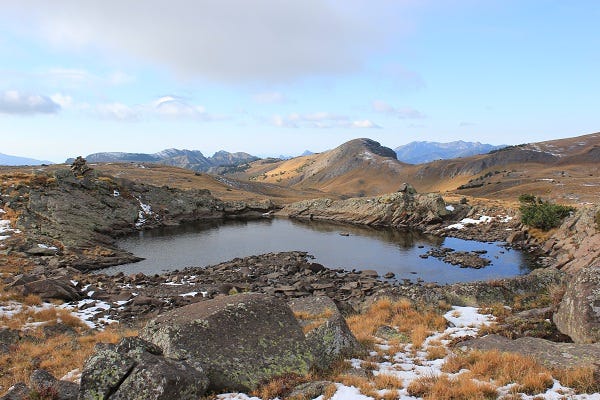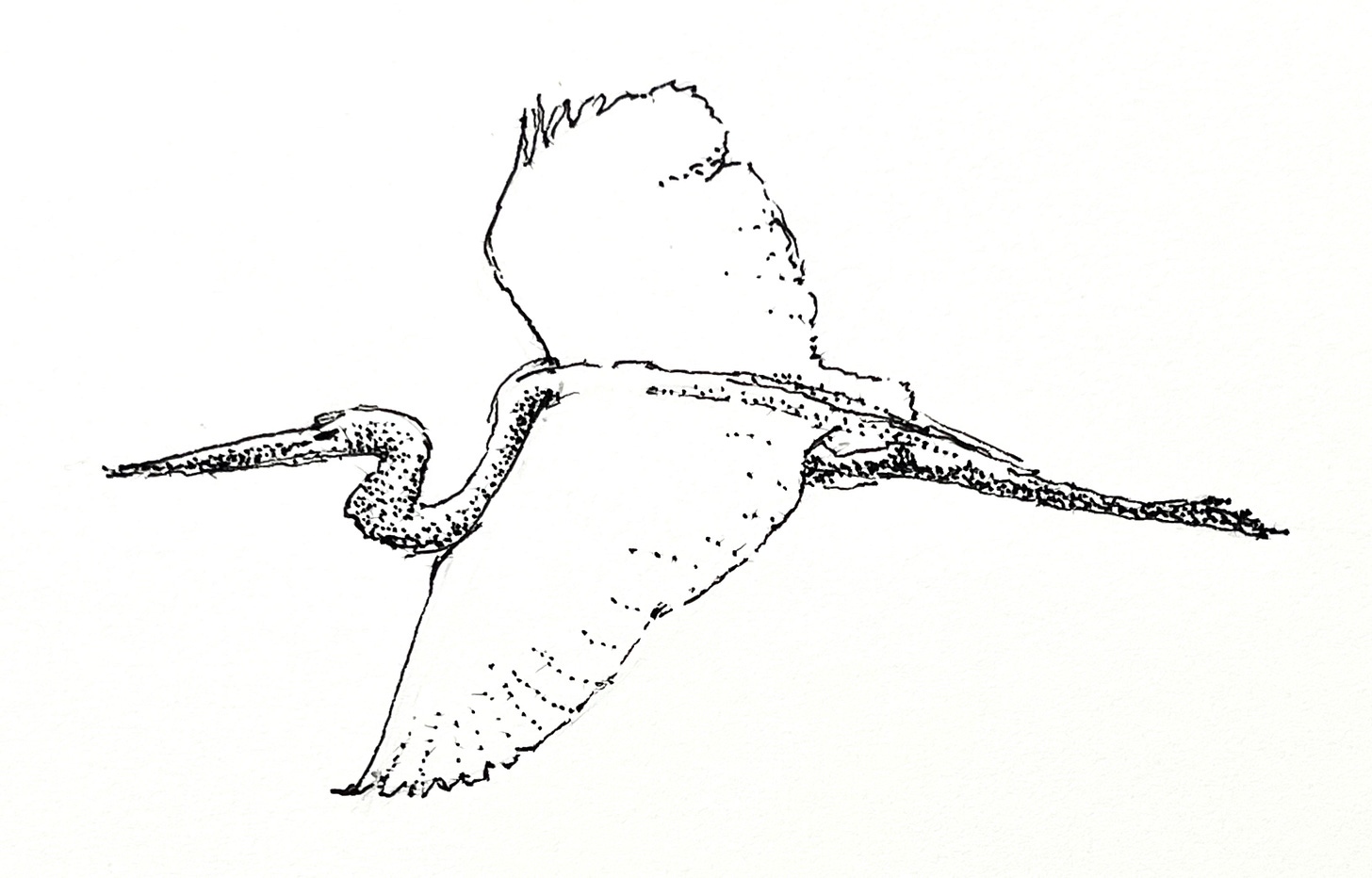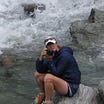Nature writer, n. A person who delights in paying attention, being astonished, and telling about it.1
“I believe if you don’t feel small, at least once in outside experiences, then you aren’t going far enough to explore the edges that define what it means to feel like a whole person. Nature has that power to invoke powerful impressions and reinforce convictions not possible in a world of manmade structures.” ~ Stacy Boone
Welcome to Season 2 of the Reciprocity interviews. My inbox is full of treasure in the form of lovingly observed writing about place, encounters both wild and gentle, imaginative kinship and renewed reciprocity. These thoughtful, talented writers kindled in me the desire to learn more about them.
Today’s guest,
returned to the east coast after living in southwest Colorado for a decade. A retired backcountry guide, she writes about the environment and how to develop one's own nature-placed relationship. She wants readers to be inspired to be outside. Her most recent writing can be found in Appalachia Journal, The Upper New Review, Five Minutes, and Quabbin Quills Anthology.I met Stacy in New Hampshire, when we were in the same MFA program. Both interested in writing about the environment, we had immediate rapport. I was delighted when she set up shop here on Substack. Her writing, whether recommending a book2, jotting fresh observations of the world3, or exploring nature-place relationships4, always makes me think (and, often, feel). Check out her recent series, a close-read of Wendell Berry’s The Need to Be Whole, with fellow Stackers and .
Her newsletter, Crooked Roots, is a place of self-exploration with nature as the backdrop. She shares a monthly, One Sentence A Day, and twice monthly essays that are inspired by her time outside and almost always with homework she feels can be implemented by readers to bring them closer to nature.
Why are you drawn to nature writing?
I have always been an advocate for going outside. I truly believe that to have wild places individuals must invest into outdoor benefits—even if they do not want to spend time there themselves. We live in a shifting baseline of knowing what nature is and how she functions. Is nature flowers like Prairie Smoke or a boulder that slowly erodes her crust and essentially buries her existence? Is nature the spongy ground that collects and holds water that sinks into the aquifer or slowly moves towards building creeks and river waterways? Is nature the Aspen tree leaves that sound like coins when they jingle in the breeze or the Tamarack that loses its needles in the fall even though she is of the Pinaceae family? This morning, for me, she is the thin spider web that hangs like a rappelers rope from a fir tree branch. This thin line dotted with snow crystals of various dissimilar designs. She is all of these things and so much more.
I write about nature because I hope to share a perspective of something unseen by casual or first-time adventurers. Or reminders for those with more nature knowledge. Delving into nature begins, for so many, with a walk on a marked trail and the experience of reaching that point is so … altering. Nature benefits humans—physically, mentally, and emotionally—and the pleasure begins with being amongst what is different. Observation comes with developing comfort and what emerges is wisdom.
How does writing about nature affect you, in your work or personal life?
When I opened my backpacking company my husband said to me, “Wait, let me get this straight, you are taking more people into the backcountry, people who can possibly impact your experience in quiet places?” He didn’t say that, he said something else but the point he made was honest. I have put a lot of miles on more boots than I can count. I have learned to crawl on my belly for a photograph with a full guide pack just so I can get the photo I really want of a client touching flowers she might have never seen before. I have made a point of learning about the history of places where I to roam to share with others. I am the witness to the “ah ha” moments often before a client even knows she is being transformed. In essence it is nature that affects my writing and work because what I write about is what I see and what I discover. I want these nuggets of nature to become images for others to visualize even if they are unable to study nature’s nuances themselves.
But, it is getting harder, meaning, sometimes learning more comes with consequences. Years ago, I learned that protecting nature requires involvement. For example, national forests revise their Master Plans every ten years. To protect the pockets of nature that remains often means saddling up to the table and being a voice in the conversation. There are few places our species has not touched, and my work now requires I bring attention to the pockets of wild spaces we still have and should keep by seeking guardrails of protection. I’ve learned that I despise cattle on public lands—6% of the beef that humans eat can overgraze native grasses and sedges, stomp down springs, and are subsidized as a part of the public lands grazing permit. I’ve learned that I love leading trail crews into the mountains to cut willow for days at a time. And knowing, even establishing my own accepted boundaries gives me fodder for writing. Knowing these things is impactful, not just on the emotional toil of resistance but in the gratification of making a difference.
While outside, have you ever experienced feeling small, lost or in danger?
I believe if you don’t feel small, at least once in outside experiences, then you aren’t going far enough to explore the edges that define what it means to feel like a whole person. Nature has that power to invoke powerful impressions and reinforce convictions not possible in a world of manmade structures.
As a backpacking guide for over 20 years, I spent much of my time sharing with recreationalists the importance of making safe decisions. To mentally work through “What If …” statements so that if something were to happen it would not be the first time to consider what to do. To temporarily misplace oneself or to make a poor decision can simply be the start of a bad spiral. Nature is beautiful but she can be ruthless for the unprepared or arrogant.
In April of 2019 I fell after crossing the Jordan Creek while hiking the Oregon Desert Trail. After crawling my way out of the tangle of creek bushes, I began the process of deciding what I needed to do to survive but I already had the tools, part of what rested in my “What If” toolbox. Did I believe myself small, definitely. Was I lost, to anyone that might be looking for me, yes. Was I in danger, absolutely (legs can bend the wrong way with a broken patella). But I also well understood that Mother Nature was not going to throw at me anything other than what I already knew—that there was too much of some things and too little of others. In the arid desert there is plenty of sun and sand and not enough water. My life depended that I negotiate around rocks up the wall to the mesa, that I be attentive for living things that might do me more harm, and that I continue making forward progress. Nature even necessitated I stop and look around to appreciate her beauty. Nature has rules, she lives in a cycle of repetition which is not a practice and understanding this allows me to be small, be lost in expansiveness, and understand danger because our species is destroying that which we need to survive.
What’s a favorite memory of nature from your childhood?
What a benefit it is to have so many. To have grown up in a time when parents called from the front porch telling kids to come home for dinner. When lunch and snacks were fed by moms at the closest house from where our dirty kneed posse played. I ran feral as a child—dirty, bruised, scratched, and free—but not alone. We walked for miles. We rode our bikes and left them at the edges of the forest (which were at least a good indicator of where to find us). The woods were home to debris constructed lodges. Creeks places to wade, to find what can only be found in water. In our big backyard our club met beneath the Loblolly pines. My memories encompass all types of weather and investigations where I found and learned something—the green’ish hue of crayfish, the light of fireflies when smeared onto a shirt, my dislike of water moccasins and copperheads. Inside was a part of play on only the most foul of weather days.
But if I must pick one moment it is a hike up Pinnacle Mountain in Arkansas that stands out the most. I vividly remember the L-O-N-G scramble up the boulders marked with rattlesnakes on every other rock (entirely fabricated) but I loved the challenge of hiking and that everywhere around my feet there was something to study. At a young age the redemptive spirit of trees permeated into my skin like the air. Outside was where I wanted to be when I grew up.
What do you hope for, for your writing?
To keep it upbeat. To offer hope and strength. To share tangible practices that all people can use to touch the soil with their fingers and toes and to not be afraid when doing so. Yet, I struggle with each of these targets.
Recently I was asked to define my intention and as I sat down with pen and paper what emerged is that my writing is shifting and I am unsure what to make of the words. Is the instability I feel a transformation of self or the landscape? What I realize is that whatever it is, is going to change the stories and essays I write. I feel a renewed requirement to meet people where they are, which is different from where I am but that is because I have a lot of nature history. I feel I am treading down the winding trail of an activist writer—and I certainly do not know how to do this or what it will look like. It took a lot of years to move away from the technical aspect of writing, to bend into the creative. It is a fine line to enrich knowledge in a way that does not cause a reader to glaze over and skip the important parts to learn. I want to write about nature to not only those within the circle, those already nodding their heads in agreement, but to those who just don’t know what there is that can excite them.
A writer or other creative artist who makes you hopeful for humanity and the earth.
I’m sure everyone says Robin Wall Kimmerer. Her writing is inspiring but what is more inspiriting is how her message was shared—passed from hand-to-hand like the gift Braiding Sweetgrass has become. I also have a special place in my heart for John McPhee, Craig Childs, and Annie Dillard. For a bit of dystopia, read Becky Chambers, A Psalm for the Wild-Built.
I am still a relative newcomer to Substack but there are an amazing group of nature writers here that should be followed. The diversity, presence of awareness, and expertise of nature writers—technical treatises, backyard observers, environmental watchdogs, and life-long outdoor lovers. I subscribe and follow various writers (in full disclosure, I maintain a strict rule of how much time I spend on Substack) and then delve into the writing depending on my mood.
I learned about recently—she requires me to slow my breath and take my time when reading because the images she shares are so layered. demands me to think as he delves into the discomfort of what we are doing to the land while also sharing hope. @ reminds me of myself before I stopped being a guide, only smarter because he continues the message of how to be a good steward of the land. gives me the permission to slow down and enjoy nature’s nuances and , one of the first Substacks I subscribed to, consents that I smile and cry, but mostly, she prompts me to lean into a well of emotional sensations.Both Stacy and I write fiction exploring our relationship with nature. I’m hoping to entice her to participate in a dare organized by
and me to explore different, less one-sided, more restorative relationships. Is it possible to use the rational tool of language to conjure our long-lost intimacy with brown bears and beetles, clouds, crabs, herons and honeybees, humpbacks, lemurs and larkspur, monarchs and maize, oaks and uncountable others?Let’s find out!
Join us as we launch the challenge tomorrow on a Substack Live. Friday, 7 March, 11:00 am EST (New York). Our subscribers will be notified by email, and you’ll likely see an invitation on Notes as well.
Each season, we donate 30% of paid subscriptions to a worthy environmental cause. This season, it’s the Center for Humans and Nature, where they explore what it means to be human in an interconnected world. Track past and current recipients here.
What did you enjoy most about this essay? I’d love to hear from you. Or share it with others by restacking on Notes, via the Substack app. Thanks!
Notes and links
If you’d like to participate in this interview series, please DM me on chat, or reach out via email: gabrielli-dot-julie-at-gmail. Find previous interviews here.
For more inspired nature writing and artwork from the best of Substack, check out the articles in NatureStack journal.
In further service to Substack’s nature writers,
curates this lovely directory of nature-focused writers:thanks, Mary Oliver
I’m indebted to this review of Andrew Krivak’s The Bear. It’s a marvelous read.
These go far beyond writing workshop exercises. By turns funny or sublime, they encourage me to pay better attention.
Ever the wilderness guide, even it’s your own backyard.











“I believe if you don’t feel small,... then you aren’t going far enough...."
SO true, Stacy!
Thank you so much for this beautifully written insight to your essays... I found myself thinking, yes, me too, so often through its entirety - you'll see or read!
Huge thanks for the mention too, I am always so surprised when someone does !